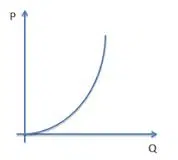 The idea of a supply curve is used in the field of economics. It must be remembered that a curve is a line that allows the graphic representation of a magnitude to be developed according to the values that one of its variables acquires. The concept of supply , on the other hand, can refer to the goods that are put up for sale in the market.
The idea of a supply curve is used in the field of economics. It must be remembered that a curve is a line that allows the graphic representation of a magnitude to be developed according to the values that one of its variables acquires. The concept of supply , on the other hand, can refer to the goods that are put up for sale in the market.
A supply curve , in this framework, refers to the quantity of a certain product that a company is willing to sell at a hypothetical price , keeping constant the rest of the factors that could alter the quantity supplied. There is a direct link between this quantity supplied and the price: the higher the price, the greater the profit for the company, which is therefore willing to sell as much of the product as possible.
The supply curve, in short, is considered increasing, because the higher the price, the higher the supply will also be. It can also be described as concave towards the axis of the ordinates , and convex towards that of the abscissa; The quantities, in this case, are the prices.
On a graph, therefore, the supply curve specifies how many products the company intends to supply for each price. At a price P1 , the seller is willing to offer a quantity Q1 ; at a price P2 , it offers the quantity Q2 ; and so on.
Suppose a pants manufacturer wants to produce and offer 1,000 pants at a price of $20 . If the price rises to $25 , the quantity supplied grows to 1,100 pants . At a price of $40 , the supply increases to 2,500 pants . All these values , in a graph, allow us to obtain the supply curve.
There is also the demand curve , which is defined as the graphic representation of the relationship between the maximum quantity of a given good or service that a consumer would want to buy, and its price. Both curves are key for the theoretical analysis of the economy when studying prices.
 From the intersection of the supply curve and the demand curve , the price of the product in the market arises, according to neoclassical economic theory. This intersection also marks the balance between supply and demand.
From the intersection of the supply curve and the demand curve , the price of the product in the market arises, according to neoclassical economic theory. This intersection also marks the balance between supply and demand.
Among the various concepts related to this topic is elasticity , which can be defined as the percentage in which the quantity of goods offered varies at the moment in which the sales price undergoes a variation of one percent. Elasticity belongs to the field of economics and its creator was Alfred Marshall , an economist of English origin.
Marshall relied on physics to find this variation (positive or negative, depending on the case) that occurs when one variable changes for another. It is important to note that the elasticity of the supply curve is linked to several factors, such as the availability of the necessary resources and the technological level of the company.
A nuance that we must clarify is that when we talk about the supply curve, it is understood that the supply referred to belongs to a single company, to the quantities of a product or service and their respective prices; If, however, the quantities offered by all companies in a particular market or sector are taken into account, then the appropriate concept is the market supply curve (it could also be the industry supply curve, as the case may be). This concept, in other words, represents the quantities that are put up for sale in a given market, at each price.
